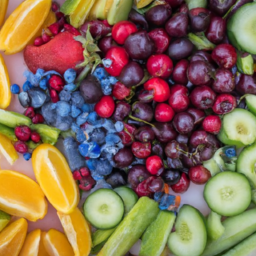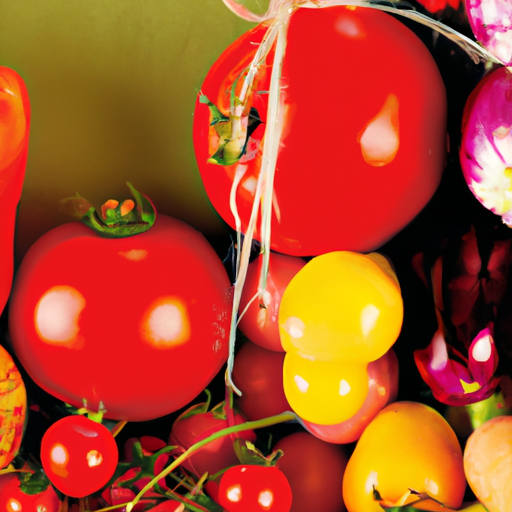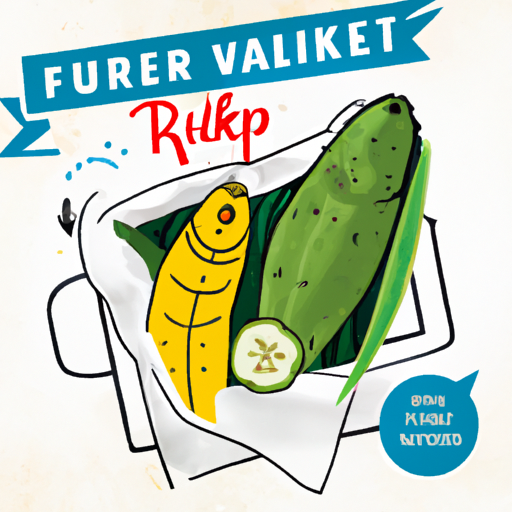Food Industry Trends
So, you’re curious about the latest trends in the food industry, huh? Well, you’ve come to the right place. In this article, we’ll be taking a closer look at some of the most exciting and groundbreaking developments that are shaping the way we produce, consume, and think about food. From plant-based alternatives and sustainable packaging to the rise of virtual restaurants and personalized nutrition, get ready to dig into the ever-evolving world of the food industry and discover what’s on the horizon. It’s time to satisfy your appetite for knowledge – let’s dig in!
Table of Contents
Technological advancements
Automated food preparation systems
Automated food preparation systems have revolutionized the food industry by streamlining the cooking process and reducing the need for manual labor. These systems are equipped with cutting-edge technology such as robotics and artificial intelligence (AI) that can efficiently handle tasks like chopping, slicing, and mixing ingredients. By automating these repetitive and time-consuming tasks, chefs and food professionals can focus on more creative aspects of food preparation, resulting in increased productivity and consistent quality.
Online food delivery platforms
The rise of online food delivery platforms has transformed the way people order and enjoy their meals. With a few taps on a smartphone or clicks on a computer, customers can have a wide variety of cuisines delivered straight to their doorstep. These platforms provide convenience and flexibility by allowing users to browse through menus, place orders, and track deliveries in real-time. Additionally, they offer a platform for small or local food businesses to reach a larger audience and expand their customer base.
Use of artificial intelligence and machine learning in food production
Artificial intelligence (AI) and machine learning (ML) have found their way into various aspects of the food industry, from optimizing supply chain management to improving food safety and quality control. AI can analyze large volumes of data to identify patterns and trends, helping businesses make informed decisions about ingredient sourcing, production processes, and distribution. Machine learning algorithms can also be used to predict consumer preferences and develop personalized recommendations for food products.
Smart packaging and labeling technologies
Smart packaging and labeling technologies have emerged as a game-changer in the global food industry. These innovative solutions incorporate sensors, QR codes, and other tracking mechanisms to provide consumers with real-time information about the product, such as expiration dates, nutritional values, and allergen warnings. Smart packaging can also help reduce food waste by monitoring temperature and freshness levels, alerting consumers and retailers when a product should be consumed or discarded. This technology not only enhances transparency and traceability but also enhances the overall consumer experience.
Sustainable practices
Organic and locally sourced ingredients
There has been a significant shift in consumer preferences towards organic and locally sourced ingredients. People are becoming more conscious about the environmental and health impacts of their food choices, leading many to opt for organic produce that is grown without chemicals and pesticides. Locally sourced ingredients not only support local farmers but also reduce the carbon footprint associated with long-distance transportation. By choosing organic and locally sourced ingredients, consumers are not only prioritizing their own well-being but also contributing to sustainable farming practices.
Reducing food waste
Food waste has long been a pressing issue for the food industry, but recent advancements have introduced innovative solutions to tackle this problem. From smart refrigerators that monitor food inventory and suggest recipes based on available ingredients to apps that connect consumers with surplus food from local restaurants and grocery stores, various technologies and initiatives are helping to reduce food waste. Moreover, businesses are finding creative ways to repurpose food waste into new products, such as using fruit peels in natural fruit-flavored water or transforming coffee grounds into compostable packaging materials.
Alternative protein sources
As the demand for sustainable and ethical food options continues to grow, alternative protein sources are gaining traction in the food industry. Plant-based proteins, such as soy, pea, and chickpea, provide a viable alternative to traditional animal-based protein sources. These plant-based options not only have a lower ecological footprint but also offer health benefits such as reduced cholesterol and improved digestion. Additionally, research and development efforts are exploring alternative protein sources such as insect-based proteins and lab-grown meat, which have the potential to revolutionize the way we produce and consume protein in the future.
Eco-friendly packaging options
Awareness about the environmental impact of plastic packaging has led to an increased demand for eco-friendly alternatives. Biodegradable, compostable, and recyclable packaging materials are gaining popularity as consumers seek more sustainable options. Food companies are embracing these materials and exploring innovative packaging designs that minimize waste and pollution. From edible packaging made from seaweed to plant-based plastics derived from renewable resources, these eco-friendly packaging options are not only reducing environmental harm but also appealing to environmentally conscious consumers.
Health and wellness
Plant-based diets and veganism
The adoption of plant-based diets and veganism has seen a significant surge in recent years, driven by concerns for animal welfare, environmental sustainability, and health benefits. Plant-based diets, which primarily consist of fruits, vegetables, whole grains, legumes, and nuts, have been linked to a reduced risk of chronic diseases such as heart disease, obesity, and type 2 diabetes. As a result, there has been a growing market for plant-based alternatives to traditional animal products, including plant-based meat substitutes, dairy alternatives, and even plant-based seafood options.
Functional and fortified foods
Consumers are increasingly seeking out functional and fortified foods that offer additional health benefits beyond basic nutrition. Functional foods are those that contain bioactive compounds or ingredients that provide specific health benefits, such as probiotics for gut health or antioxidants for immune support. Fortified foods, on the other hand, are enhanced with additional nutrients, such as vitamins, minerals, or omega-3 fatty acids, to address specific nutritional deficiencies or support overall well-being. The market for functional and fortified foods has expanded to include a wide range of products, from fortified cereals and beverages to functional snacks and supplements.
Reduced sugar and salt content
With growing concerns about the negative health effects of excessive sugar and salt consumption, there has been a shift towards products with reduced sugar and salt content. Food manufacturers are reformulating recipes and incorporating natural alternatives to sugar and salt, such as stevia or herbs and spices, to maintain flavor while reducing the overall content of these ingredients. The demand for reduced sugar and salt options extends beyond processed foods and beverages, with consumers also seeking healthier alternatives in baked goods, sauces, and condiments.
Clean label products
Clean label products are gaining popularity as consumers seek more transparency in food labeling and ingredients. Clean label refers to food products that have a simple and easily understandable ingredient list, free from artificial additives, preservatives, and chemicals. This trend reflects a desire for more natural and wholesome food choices that align with consumers’ preferences for healthy and minimally processed options. Clean label products often emphasize the use of recognizable ingredients and minimal processing methods to maintain the nutritional integrity and authenticity of the food.
Convenience and on-the-go options
Ready-to-eat meals
Ready-to-eat meals offer convenience and time-saving solutions for busy individuals who are looking for quick and easy meal options. These meals are typically fully cooked and require minimal preparation, allowing consumers to enjoy a nutritious meal without the need for extensive cooking skills or kitchen equipment. Ready-to-eat meals come in various formats, including microwavable dishes, pre-packaged salads, sandwiches, and even frozen meals. The convenience factor and diverse range of options have made ready-to-eat meals a popular choice for those seeking hassle-free dining experiences.
Meal kits and subscription services
Meal kits and subscription services have become increasingly popular, offering consumers a convenient way to prepare meals at home without the need for extensive grocery shopping or meal planning. These services provide pre-portioned ingredients along with detailed recipes, allowing individuals to cook restaurant-quality meals in the comfort of their own kitchens. Meal kits cater to a wide range of dietary preferences and offer customization options to suit individual needs. In addition to convenience, meal kits also reduce food waste by providing precisely measured ingredients, minimizing the chances of excess food being thrown away.
Grab-and-go snacks
The demand for grab-and-go snacks has surged in recent years as consumers prioritize convenience and seek out healthier snacking options. These snacks are typically portable, individually packaged, and offer a quick, on-the-go solution to satisfy hunger cravings. The market for grab-and-go snacks includes a wide variety of options, ranging from protein bars and fruit cups to vegetable chips and single-serve yogurt cups. As consumers increasingly prioritize health and wellness, many brands are focusing on offering snacks that are not only convenient but also made from wholesome ingredients and free from artificial additives.
Mobile ordering apps
Mobile ordering apps have revolutionized the way people order food, providing a seamless and efficient way to place orders for pickup or delivery. These apps allow users to browse menus, customize their orders, and make secure payments all within a few taps on their smartphones. By eliminating the need for phone calls or physical menus, mobile ordering apps not only enhance convenience but also reduce the chances of miscommunication or errors in orders. Additionally, these apps often offer personalized recommendations, loyalty rewards, and discounts, further enhancing the overall dining experience for users.
Global flavors and ethnic cuisine
Increased popularity of international cuisines
The globalization of food has led to an increased popularity and accessibility of international cuisines. Consumers are increasingly adventurous in their food choices and seeking out flavors and dishes from around the world. Restaurants and food establishments are catering to this demand by exploring diverse international cuisines and incorporating global flavors into their menus. From Thai and Mexican to Ethiopian and Korean, the options for experiencing global flavors are expanding, allowing individuals to explore and appreciate different culinary traditions.
Fusion foods
Fusion foods have gained a significant following, blending culinary influences from different cultures to create unique and exciting flavor combinations. These innovative and often unexpected combinations have captivated food enthusiasts and offered a fresh perspective on traditional dishes. Fusion cuisine draws inspiration from various culinary traditions and can range from Asian-Mexican fusion tacos to Mediterranean-inspired sushi rolls. The fusion food trend showcases the creativity and versatility of chefs and allows for the exploration of new culinary territories.
Authentic ethnic ingredients and cooking techniques
As consumers become more adventurous with their taste buds, there is a growing demand for authentic ethnic ingredients and cooking techniques. People are seeking out specialty ingredients, spices, and condiments from different cultures to recreate traditional dishes at home. Food retailers are responding to this demand by stocking a wider range of ethnic ingredients, making them more accessible to a broader audience. Additionally, cooking classes and workshops focused on teaching traditional ethnic cooking techniques have gained popularity, allowing individuals to learn and appreciate the nuances of different cuisines.
Food tourism
Food tourism has become a significant industry, with travelers seeking out destinations known for their culinary offerings. Exploring local food scenes, trying traditional dishes, and experiencing unique dining experiences have become integral parts of travel itineraries. From street food markets and food festivals to farm-to-table experiences and cooking classes, food tourism allows individuals to immerse themselves in the local culture and authentic flavors of a destination. It provides an opportunity to learn about different culinary traditions, interact with local producers and chefs, and create memorable gastronomic experiences.
Personalization and customization
Customized meal plans
With the emphasis on individual dietary needs and preferences, customized meal plans have gained popularity. These plans are tailored to meet specific nutritional requirements, address dietary restrictions, or achieve health and wellness goals. Customized meal plans take into account factors such as caloric intake, macronutrient distribution, portion sizes, and allergen concerns. They can be designed for various dietary preferences, including vegetarian, vegan, gluten-free, or keto, among others. By providing personalized recommendations and meal options, these plans empower individuals to make informed choices and take control of their nutrition.
Made-to-order food choices
Made-to-order food choices provide individuals with the flexibility to personalize their meals according to their specific tastes and preferences. Whether it’s choosing a protein option, selecting toppings or condiments, or customizing a dish to be spicy or mild, made-to-order options cater to individual preferences. This level of customization allows consumers to have more control over their dining experience, ensuring that their meals are prepared to their liking. Made-to-order food choices can be found in various food establishments, from fast-food chains offering build-your-own burgers to upscale restaurants providing customizable tasting menus.
Personalized nutrition and dietary advice
Advancements in technology and nutrition science have enabled the development of personalized nutrition and dietary advice. Through the use of apps, online platforms, and wearable devices, individuals can track their food intake, monitor their nutritional status, and receive personalized recommendations based on their unique needs. These tools analyze various factors like age, gender, weight, activity level, and personal goals to create personalized dietary plans and offer advice for achieving optimal health and wellness. Personalized nutrition has the potential to revolutionize the way people approach their diets and make informed decisions about their food choices.
Customizable food packaging
Customizable food packaging offers a unique and interactive experience for consumers. From personalized labels and packaging designs to on-pack QR codes that provide additional information or interactive elements, customizable packaging allows individuals to create a personal connection with the product. This trend goes beyond aesthetics and offers practical features such as portion-controlled packaging, resealable options, or modular designs that allow for easy customization and portioning. Customizable food packaging enhances the overall consumer experience and creates a sense of ownership and personalization.
Transparency and traceability
Consumer demand for transparency in food sourcing
Consumers are increasingly concerned about the origins of their food and are demanding greater transparency in food sourcing. They want to know where their food comes from, how it was grown or raised, and the practices involved in its production. This demand for transparency extends to factors such as sustainability, animal welfare, and fair trade practices. In response, food companies are providing more detailed information about their supply chains, partnering with third-party certification programs, and implementing traceability systems to ensure accountability and build trust with consumers.
Blockchain technology for supply chain management
Blockchain technology has emerged as a powerful tool for enhancing transparency and traceability in the food industry. By utilizing a decentralized and secure digital ledger, blockchain can track and verify every step of a food product’s journey from farm to fork. This technology allows for real-time visibility into the supply chain, ensuring that information about the product, including its origin, quality, and handling procedures, is accurately recorded and accessible. Blockchain also enables consumers to verify the authenticity and ethical sourcing of the food they purchase, fostering greater trust and confidence in the food system.
Usage of QR codes to provide detailed product information
QR codes have become increasingly common on food packaging, providing consumers with easy access to detailed product information. By scanning the QR code with a smartphone, consumers can learn more about the product’s ingredients, nutritional value, allergen warnings, and even the story behind its production. QR codes also provide an opportunity for companies to share additional content such as recipes, cooking tips, or sustainability initiatives. This technology not only enhances transparency but also engages consumers, allowing them to make informed choices and build a deeper connection with the brand.
Certifications and labeling for sustainable and ethical practices
Certifications and labeling initiatives play a vital role in providing consumers with assurance that their food is produced using sustainable and ethical practices. From organic and fair trade certifications to animal welfare labels and eco-friendly symbols, these certifications help consumers navigate the increasingly complex landscape of food choices. They provide credibility and third-party verification, ensuring that claims made by food companies are backed by rigorous standards and practices. By choosing products with recognized certifications, consumers can make conscious choices that align with their values and promote sustainable and ethical food production.
Innovations in food production
Cellular agriculture and lab-grown meat
Cellular agriculture, also known as cultured or lab-grown meat, is a revolutionary approach to food production that aims to produce meat without the need for traditional livestock farming. The process involves culturing animal cells in a lab, which are then grown into meat products. Cellular agriculture has the potential to address environmental concerns associated with conventional meat production, such as land use, greenhouse gas emissions, and animal welfare. While still in the early stages of development, this innovation offers a glimpse into the future of sustainable and ethical meat production.
3D-printed food
3D-printing technology has made its way into the food industry, allowing for the creation of intricate and personalized food designs. By layering edible materials, such as dough, chocolate, or even plant-based proteins, 3D printers can produce unique food shapes and structures that were previously impossible to achieve manually. This technology opens up possibilities for customized food creations, catering to individual preferences or dietary needs. Additionally, 3D-printing can have applications in specialized diets, such as creating foods with modified textures or enhancing nutritional profiles.
Alternative ingredients and food substitutes
The search for sustainable and healthier alternatives to traditional ingredients has led to the emergence of alternative ingredients and food substitutes. From plant-based proteins like tofu and tempeh to dairy alternatives such as almond milk and coconut yogurt, these alternatives offer options for those with dietary restrictions or who are looking to reduce their environmental impact. Additionally, advancements in food science have paved the way for alternative ingredients derived from unconventional sources, such as insects or microalgae, which offer unique nutritional benefits and contribute to a more diverse and sustainable food system.
Vertical farming and urban agriculture
Vertical farming and urban agriculture are innovative approaches to food production that prioritize efficiency, sustainability, and urbanization. Vertical farming involves growing crops in vertically stacked layers or structures, often indoors, using techniques such as hydroponics or aeroponics. This method enables year-round production, optimum resource utilization, and eliminates the need for extensive land use. Urban agriculture focuses on cultivating food in urban areas, utilizing available spaces such as rooftops, balconies, or community gardens. These practices promote local food production, reduce transportation distances, and increase access to fresh produce in urban food deserts.
Changing consumer preferences
Preference for natural and clean label products
Consumers’ preferences are shifting towards natural and clean label products that are free from artificial additives, preservatives, and chemicals. They want to know exactly what is in their food and, more importantly, what is not. Clean label products provide a level of transparency that resonates with health-conscious consumers who prioritize the quality and purity of their food choices. This preference for natural and clean label products extends to a wide range of food categories, including beverages, snacks, condiments, and even pet food.
Focus on locally sourced and artisanal foods
Consumers are increasingly seeking out locally sourced and artisanal foods as they prioritize supporting local communities and experiencing unique flavors. Locally sourced foods offer freshness and traceability, often grown or produced within a limited radius of where they are sold. Artisanal foods refer to products that are made in small batches using traditional or specialized techniques, often by skilled craftsmen or small-scale producers. These foods convey a sense of craftsmanship, authenticity, and cultural heritage, appealing to those who seek unique and high-quality food experiences.
Demand for plant-based alternatives to animal products
The demand for plant-based alternatives to traditional animal products has seen a dramatic rise in recent years. Driven by concerns for animal welfare, environmental sustainability, and personal health, consumers are actively seeking out plant-based options for meat, dairy, and eggs. Plant-based meat substitutes, such as burgers, sausages, and chicken alternatives, have gained significant popularity, with major food companies and fast-food chains introducing plant-based options on their menus. The demand for plant-based alternatives extends beyond meat, with plant-based milks, cheeses, and ice creams also experiencing a surge in popularity.
Interest in functional and health-promoting ingredients
Consumers are increasingly interested in functional and health-promoting ingredients that offer specific benefits beyond basic nutrition. Ingredients like turmeric, matcha, goji berries, and adaptogens are gaining traction due to their potential antioxidant, anti-inflammatory, or stress-reducing properties. Functional ingredients offer consumers an opportunity to enhance their well-being and vitality through their food choices. These ingredients can be found in various food and beverage products, including smoothies, protein bars, and functional beverages, catering to the growing demand for health-conscious options.
Digital marketing and social media influence
Impact of social media in food choices
Social media platforms have had a profound impact on how people discover, share, and choose their food. From visually appealing food photos on Instagram to viral recipe videos on TikTok, social media plays a crucial role in shaping food trends and influencing consumer preferences. Food-related content creators and influencers have amassed large followings, often becoming trusted sources of culinary inspiration and recommendations. The power of social media in driving food choices has prompted food businesses to leverage these platforms for marketing, engagement, and building brand loyalty.
Influencer collaborations and endorsements
Food influencers and content creators have become influential figures in the food industry, collaborating with brands and endorsing products to their online communities. These collaborations often take the form of sponsored content, where influencers promote a brand or product through creative and engaging content. By partnering with influencers, food companies can tap into their established audiences, benefit from their credibility and authenticity, and reach a broader demographic. Influencer collaborations help create buzz and generate brand awareness, ultimately driving consumer interest and sales.
Virtual cooking classes and tutorials
Virtual cooking classes and tutorials have become increasingly popular, allowing individuals to learn new recipes and cooking techniques from the comfort of their own homes. With the rise of video platforms and live streaming services, chefs and cooking instructors can share their expertise and interact with aspiring home cooks in real-time. Virtual cooking classes offer convenience, flexibility, and accessibility, allowing participants to learn at their own pace and from a diverse range of culinary experts. These classes have gained traction during the COVID-19 pandemic, providing an avenue for culinary education and entertainment while adhering to social distancing guidelines.
Online food communities and reviews
Online food communities and review platforms have transformed the way people discover and evaluate food establishments. Websites and apps like Yelp, TripAdvisor, and Google Reviews provide a platform for users to share their dining experiences, rate restaurants, and leave feedback. These platforms have empowered consumers to make informed decisions based on the experiences and recommendations of others. Online food communities also foster engagement and discussions around food-related topics, creating a sense of community and connecting like-minded individuals who share a passion for food.
In conclusion, the food industry is evolving and adapting to changing consumer preferences, technological advancements, and sustainability concerns. From technological innovations in food production to a growing demand for sustainable and personalized options, these trends are shaping the way we produce, consume, and experience food. As consumers continue to prioritize health, wellness, convenience, and transparency, the food industry must embrace these trends to meet the evolving needs and expectations of its customers.






